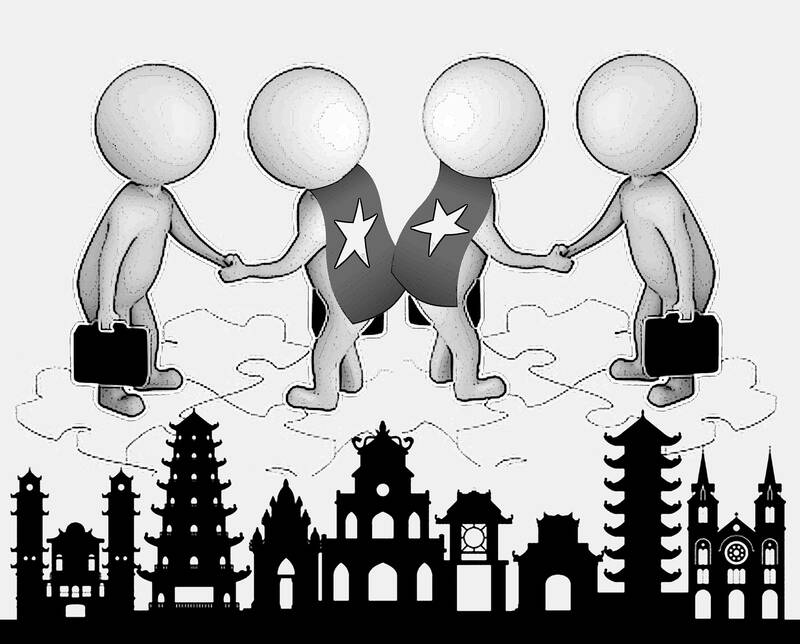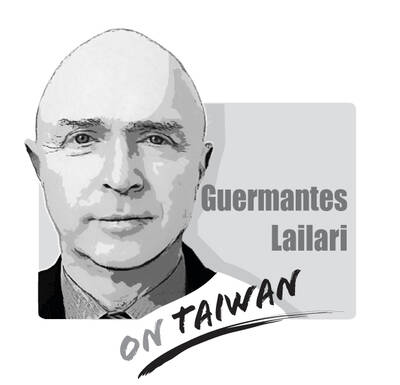Vietnam has become the flavor of the year for the world’s geopolitical rivals.
In September, US President Joe Biden visited the Southeast Asian powerhouse, signing a comprehensive strategic partnership that places Washington’s relations with Vietnam on par with Beijing’s.
This week, Chinese President Xi Jinping (習近平) followed suit, with the two nations signing 37 agreements, including China funding a cross-border railway and holding joint maritime patrols. The neighbors also agreed on a three-year plan to boost trade.

Illustration: Constance Chou
The US and China are eager to drag Hanoi to their side — but the communist country should stick to its long stance of non-alignment and act in its own best interests. This multipolar foreign policy strategy would ensure the nation exerts agency in dealing with the world’s two largest economies. It could also use the influence it has with both to bring them closer together and work on issues of global importance, such as climate change, future pandemics and the use of nuclear weapons.
It makes sense for the US and China to court Vietnam, one of the region’s most dynamic economies. This year, it is expected to post about 5 percent growth, better than many others. Foreign direct investment until October surged 14.7 percent from the same period last year. The manufacturing hub benefits from being integrated with China’s economy, but also attracts investment from companies such as Intel Corp, and suppliers to Apple Inc and Nvidia Corp.
During his visit, Biden elevated US ties with Hanoi to the highest diplomatic level, describing the push as the “beginning of a great era of cooperation.” Xi emphasized the importance of building a “community of common destiny” together.
China is watching its communist neighbor’s increasingly closer relations with Washington with interest. After Biden’s visit, Vietnamese President Vo Van Thuong in October traveled to Beijing to meet with Xi. The Chinese leader told him that the two countries have developed a deep friendship of “camaraderie and brotherhood,” and that they should regard the bilateral relationship as a priority in their respective foreign policies — a veiled reference, or a reminder perhaps, of keeping ties strong, no matter how much the US comes knocking.
Beijing has long-standing economic relations with Hanoi, but could do more to bring big-name Chinese companies to invest, former Vietnamese ambassador to the US Nguyen Quoc Cuong said from Hanoi.
“China is lagging behind some other countries, namely the US, in this regard. Personally, I would like to see big names like the Chinese versions of Apple or Intel in the high tech space, and the digital economy investing more here,” he said.
However, while using economic incentives to gain political leverage might be what the great powers are trying, the strategy is unlikely to be that straightforward. Vietnam can be expected to continue to be guided by a foreign policy that has allowed it to strike relationships with countries that are often at odds with one another.
It is not just about managing the US and China, said Lye Liang Fook, senior fellow at the Singapore-based ISEAS-Yusof Ishak Institute.
“There is a new upgraded relationship with Japan as well. This visit by Xi is another indication of Vietnam’s delicate balancing act, but it also shows how the country has been striking a healthy equilibrium with the major powers,” he said.
This equilibrium is what is often referred to as Vietnam’s “bamboo diplomacy,” or its experience in balancing competing geopolitical interests in the past three decades. The policy takes its name from the attributes of the bamboo plant: strong and durable, yet flexible and adaptable.
Although already in practice for several years, the term was first officially coined by Communist Party of Vietnam General Secretary Nguyen Phu Trong in 2016, and has since been a hallmark of how the once-impoverished nation deals with its neighbors. The central purpose is to avoid conflict, and promote peace.
Hanoi has shaped a deft and strategic network of relationships with large and small powers that has allowed Vietnam to balance not just the interests of the US and China, but also to navigate Russia, which assisted in its postwar reconstruction era.
Trade has been a vital part of outreach. Three decades ago, isolated and slowly emerging from the ravages of the Vietnam War, the nation had business relations with only about 30 countries and territories. Today, that figure is more than 150 and includes a number of free-trade agreements.
Hanoi should continue using trade and bamboo diplomacy, even as geopolitics become more complex and superpowers compete for influence and investment.
Xi’s visit is his second since 2017 when he went to Danang for an APEC meeting. I observed the Chinese leader’s calm and composed speech pitching the Chinese Dream — his vision for economic and military rejuvenation. He was following then-US president Donald Trump, whose remarks in contrast promoted the concept of “America First.”
The competition between the two countries, despite the change in leadership in Washington, has only become more acute today. That is why Vietnam’s strategy of looking after its own interests first is likely to ensure it maintains influence, as well as economic and political success.
It is also a major stakeholder in the South China Sea. While Beijing has historically bristled at the notion of any interference in the contested waterway it says China mostly owns, it has not deployed the forceful response to Hanoi’s objections the way it has with the Philippines, partly because of Vietnam’s independent foreign strategy.
Cooperation rather than conflict has been a key part to how Vietnam has engaged with competing interests and not just survived, but thrived. Other countries would be wise to learn from Hanoi’s example.
Karishma Vaswani is a Bloomberg Opinion columnist covering Asian politics with a special focus on China. Previously, she was the BBC’s lead Asia presenter and worked for the BBC across Asia and South Asia for two decades.
This column does not necessarily reflect the opinion of the editorial board or Bloomberg LP and its owners.

“History does not repeat itself, but it rhymes” (attributed to Mark Twain). The USSR was the international bully during the Cold War as it sought to make the world safe for Soviet-style Communism. China is now the global bully as it applies economic power and invests in Mao’s (毛澤東) magic weapons (the People’s Liberation Army [PLA], the United Front Work Department, and the Chinese Communist Party [CCP]) to achieve world domination. Freedom-loving countries must respond to the People’s Republic of China (PRC), especially in the Indo-Pacific (IP), as resolutely as they did against the USSR. In 1954, the US and its allies
A response to my article (“Invite ‘will-bes,’ not has-beens,” Aug. 12, page 8) mischaracterizes my arguments, as well as a speech by former British prime minister Boris Johnson at the Ketagalan Forum in Taipei early last month. Tseng Yueh-ying (曾月英) in the response (“A misreading of Johnson’s speech,” Aug. 24, page 8) does not dispute that Johnson referred repeatedly to Taiwan as “a segment of the Chinese population,” but asserts that the phrase challenged Beijing by questioning whether parts of “the Chinese population” could be “differently Chinese.” This is essentially a confirmation of Beijing’s “one country, two systems” formulation, which says that
On Monday last week, American Institute in Taiwan (AIT) Director Raymond Greene met with Chinese Nationalist Party (KMT) lawmakers to discuss Taiwan-US defense cooperation, on the heels of a separate meeting the previous week with Minister of National Defense Minister Wellington Koo (顧立雄). Departing from the usual convention of not advertising interactions with senior national security officials, the AIT posted photos of both meetings on Facebook, seemingly putting the ruling and opposition parties on public notice to obtain bipartisan support for Taiwan’s defense budget and other initiatives. Over the past year, increasing Taiwan’s defense budget has been a sore spot
Media said that several pan-blue figures — among them former Chinese Nationalist Party (KMT) chairwoman Hung Hsiu-chu (洪秀柱), former KMT legislator Lee De-wei (李德維), former KMT Central Committee member Vincent Hsu (徐正文), New Party Chairman Wu Cheng-tien (吳成典), former New Party legislator Chou chuan (周荃) and New Party Deputy Secretary-General You Chih-pin (游智彬) — yesterday attended the Chinese Communist Party’s (CCP) military parade commemorating the 80th anniversary of the end of World War II. China’s Xinhua news agency reported that foreign leaders were present alongside Chinese President Xi Jinping (習近平), such as Russian President Vladimir Putin, North Korean leader Kim